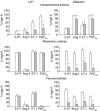Hypoxic pulmonary vasoconstriction: mechanisms and controversies
- PMID: 16254010
- PMCID: PMC1464287
- DOI: 10.1113/jphysiol.2005.098855
Hypoxic pulmonary vasoconstriction: mechanisms and controversies
Abstract
The pulmonary circulation differs from the systemic in several important aspects, the most important being that pulmonary arteries constrict to moderate physiological (20-60 mmHg PO2) hypoxia, whereas systemic arteries vasodilate. This phenomenon is called hypoxic pulmonary vasoconstriction (HPV), and is responsible for maintaining the ventilation-perfusion ratio during localized alveolar hypoxia. In disease, however, global hypoxia results in a detrimental increase in total pulmonary vascular resistance, and increased load on the right heart. Despite many years of study, the precise mechanisms underlying HPV remain unresolved. However, as we argue below, there is now overwhelming evidence that hypoxia can stimulate several pathways leading to a rise in the intracellular Ca2+ concentration ([Ca2+]i) in pulmonary artery smooth muscle cells (PASMC). This rise in [Ca2+]i is consistently found to be relatively small, and HPV seems also to require rho kinase-mediated Ca2+ sensitization. There is good evidence that HPV also has an as yet unexplained endothelium dependency. In this brief review, we highlight selected recent findings and ongoing controversies which continue to animate the study of this remarkable and unique response of the pulmonary vasculature to hypoxia.
Figures


References
-
- Aaronson PI, Robertson TP, Ward JP. Endothelium-derived mediators and hypoxic pulmonary vasoconstriction. Respir Physiol Neurobiol. 2002;132:107–120. - PubMed
-
- Archer S, Michelakis E. The mechanism(s) of hypoxic pulmonary vasoconstriction: potassium channels, redox O2 sensors, and controversies. News Physiol Sci. 2002;17:131–137. - PubMed
-
- Archer SL, Souil E, nh-Xuan AT, Schremmer B, Mercier JC, El YA, Nguyen-Huu L, Reeve HL, Hampl V. Molecular identification of the role of voltage-gated K+ channels, Kv1.5 and Kv2.1, in hypoxic pulmonary vasoconstriction and control of resting membrane potential in rat pulmonary artery myocytes. J Clin Invest. 1998;101:2319–2330. - PMC - PubMed
-
- Archer SL, Wu XC, Thebaud B, Nsair A, Bonnet S, Tyrrell B, McMurtry MS, Hashimoto K, Harry G, Michelakis ED. Preferential expression and function of voltage-gated, O2-sensitive K+ channels in resistance pulmonary arteries explains regional heterogeneity in hypoxic pulmonary vasoconstriction: ionic diversity in smooth muscle cells. Circ Res. 2004;95:308–318. - PubMed
-
- Burghuber OC. Nifedipine attenuates acute hypoxic pulmonary vasoconstriction in patients with chronic obstructive pulmonary disease. Respiration. 1987;52:86–93. - PubMed
Publication types
MeSH terms
Substances
LinkOut - more resources
Full Text Sources
Miscellaneous

